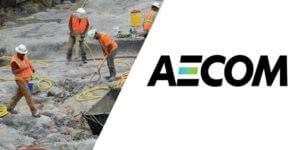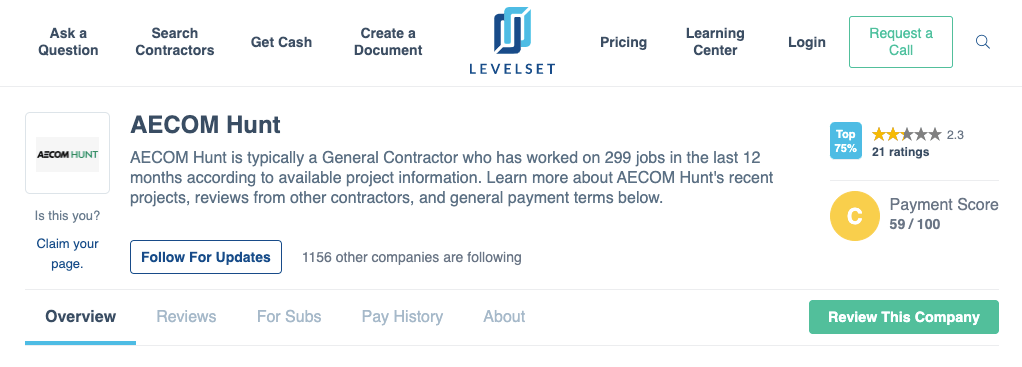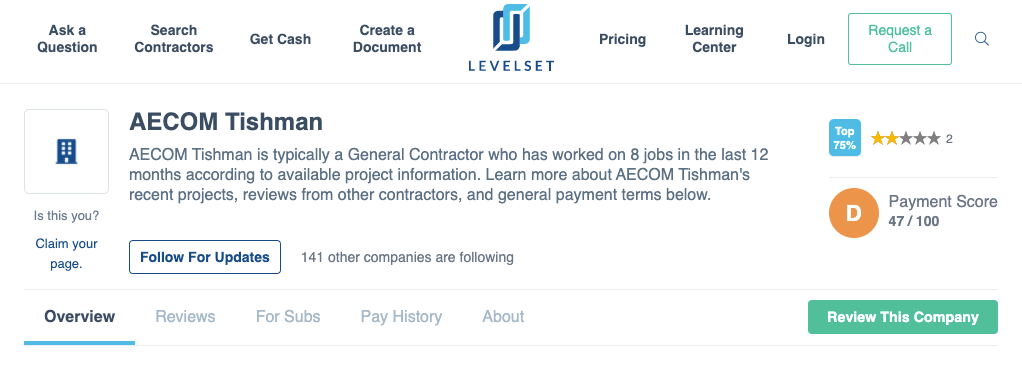
Considering subcontracting with AECOM Construction? You’ve come to the right place. For many suppliers and subcontractors, working with a general contractor like AECOM can be an opportunity to level-up your business. However, you still need to make sure working with AECOM is right for you. The construction industry can be unpredictable. No matter how big or small the general contractor, slow payment is an all-too-common occurrence.
This subcontractor guide introduces you to AECOM and can help you increase your chances of getting paid on time by giving you an idea of AECOM’s payment history, general prequalification procedures, payment process, and more.
About AECOM Construction
AECOM is a multinational engineering firm and general contractor. AECOM became a leading construction company after their acquisition of AECOM Hunt in 2014 and AECOM Tishman in 2010. View their website to learn more about the company.
AECOM officially started in 1990 after the merger of five major companies, but many of their predecessors have histories that date back to over 120 years ago. To this day, more than 50 companies have joined the AECOM family, making AECOM one of the largest companies on the planet.
In 2019, AECOM pulled in $13.6 billion in revenue, putting them in third place on ENR’s Top 400 Contractors list for 2020. AECOM became a publicly traded company on the NYSE in 2007, and they currently sit in 163rd place in the Fortune 500.
AECOM’s global headquarters is located in Los Angeles, and they have regional offices in London, Abu Dhabi, Hong Kong, Singapore, Brisbane, and Gurugram.
AECOM operates in a wide number of industries, including Energy, Healthcare, National Governments, Transportation, and Water.
The services AECOM provides include:
AECOM Notable Projects
AECOM has an impressive portfolio of large projects, including:
- One World Trade Center
- The Port of Los Angeles Waterfront
- The Mercedes Benz Stadium
- Golden 1 Center
- Warner Bros. World Abu Dhabi
Before Working with AECOM
GCs like AECOM prequalify their subcontractors, and subcontractors should always prequalify their GCs. Performing a prequalification for a general contractor before you sign a contract is a great way to make sure the job is right for you.
Subcontractors can follow a five-step prequalification process to get a better idea of who they’re planning to work with:
- Review the GC’s payment history
- Review the GC’s credit history
- Read reviews and advice from other subcontractors who have worked with the GC
- Contact the GC and learn about their payment process
- Take a look at a sample subcontract from your GC
These five steps help you to acquaint yourself with the general contractor, the subcontract, and the project. The more you know before you sign, the more prepared you’ll be to take on the project. And, when it’s all said and done, you’ll be better equipped to properly apply for payment and collect in-full and on-time.
To begin prequalifying AECOM, subcontractors should refer to their Contractor Profile. AECOM has two payment profiles because operations are split between two companies: AECOM Hunt and AECOM Tishman.
AECOM Hunt
AECOM Hunt currently has a “C” payment score. Their payment process is currently rated 2.3 stars out of 5 based on 21 subcontractor reviews.

Payment score refers to AECOM Hunt’s payment speed, and it’s calculated using the company’s payment data compared to a database of other thousands of other GCs across the country. Learn more about how payment scores are calculated.
14% of reviews have given AECOM Hunt a five-star rating, and 44% have given the GC a one-star rating.
Their most recent positive review gives them four stars, stating: “It’s mostly pay when paid and they pay within the time allocated by prompt pay statute.”
Their most recent negative review gives them one star, stating: “Frequent and regular runarounds. Two years to get final payoff after [a] protracted legal battle. Recommend against doing future business with this company.”
AECOM Tishman
AECOM Tishman has a “D” payment score, as well as two stars out of five based on two reviews.

Unfortunately, the only available review for AECOM Tishman rates them with one star and states: “Horribly run project, not typical of their work. Ethically questionable and no communication.”
Recent Payment Disputes
AECOM Construction has experienced a few mechanics lien filings in recent months.
Most notably, multiple mechanics liens were filed on the MSG Sphere project in Las Vegas, a project which had AECOM as the general contractor. The liens total $3.37 million, and AECOM has bonded one of them. These liens were filed between June and April of 2020.
AECOM also faces four mechanics liens filed on projects in Plano, TX, Houston, TX, and Brooklyn, NY. These were filed since July of 2020, and total over $394K.
It’s important to note that not all payment disputes are the general contractor’s fault. The construction industry is widely known for slow payment times, and the unpredictable nature of each construction project only adds fuel to the fire.
Furthermore, the larger the project is, the more subcontractors are participating. This alone leads to confusion and instances of slow payment.
AECOM Construction’s Payment Process for Subcontractors
AECOM has a relatively straightforward prequalification process and payment process. On AECOM’s Contact Us page, AECOM states that all vendor, supplier, and subcontractor relations are handled at the local level. This means that companies that wish to subcontract with AECOM will need to contact their local office in order to begin pre-qualifying.
Getting Prequalified
After you get in touch with your local office, you can create a profile on AECOM’s portal for subcontractors and suppliers, SUBPORT. All prospective subs and suppliers must go through the prequalification process by submitting a questionnaire through that portal.
AECOM Construction requires subcontractors to supply some basic information about their company on the questionnaire. That information may include:
- QA/QC processes
- Health and safety information
- A description of services
- Licensing information
- Information about labor and equipment
- OSHA logs for the past three years
- Company safety information for the past three years
- Company environmental information
After you submit your prequalification form, it will be distributed to all relevant project managers in AECOM Americas.
For more information, read through AECOM’s FAQ page for the SUBPORT portal.
Before the Job Begins
After you’ve been prequalified to work with AECOM, there are still a few pieces of information you need to provide before work on the project can begin.
Generally, contractors will need to provide the following to the project administrator:
- A copy of the subcontract
- Any bonds on the project
- Proof of insurance
- A copy of your W-9 form
The information you need to provide depends on a few circumstances, such as whether or not you’ve worked with AECOM in the past, and the type of project.
Applying for First Payment
Applying for first payment on a project with a large general contractor may look intimidating, but the process is relatively simple.
General contractors tend to use the industry standard for pay applications: the AIA billing forms. You can expect to send the G702 Application for Payment and G703 Continuation Sheet when applying for your first payment.
Always make sure you fill out your pay apps completely, and that the information you include is 100% accurate. Mistakes on your pay app could cause payment delays for your first and subsequent payments.
Applying for Progress Payments
Progress payments are a great way for a general contractor to keep track of a subcontractor’s progress and make sure the cash flow on the project is steady.
If you’d like to apply for progress payments while working with AECOM, you’ll need to provide them with a pay app, a schedule of values, and any lien waivers, if requested.
AECOM may also request additional information depending on your contract terms.
Applying for Final Payment
Applying for final payment with a general contractor generally involves the following:
- Sending your last pay app
- Completing any close-out documents
- Singing any lien waivers
Your AECOM project administrator will let you know if there are any additional steps you need to take in order to apply for your final payment.
3 Tips for Subcontractors to Get Paid on AECOM Construction Projects
No matter who the general contractor is on the construction project, you should approach each project with a certain level of caution: There’s no telling what challenges you may face in terms of payment down the road.
Subcontractors have the legal right to get paid, but they often have to take steps to protect those rights. Incorporating these best practices can greatly increase your chances of getting paid on time, and leaves you with recovery options in the event of non-payment.
1. Always send a preliminary notice.
Sending a preliminary notice on every project is a great practice, whether the project requires one or not. For one, they improve communication on the project by letting everyone know who you are and what you’re doing.
Furthermore, sending a notice is a requirement to preserve your lien rights in most states. Failure to send a preliminary notice could strip you of your lien rights and severely limit your options for recovery if you don’t get paid.
2. Review lien waivers.
Lien waivers are commonly exchanged when it’s time for payment. In broad strokes, in exchange for payment, you agree not to file a mechanics lien.
Because these document can forfeit your lien rights, it’s important to look over lien waivers with a construction attorney. This way, you’ll get the best possible deal and ensure you’re covered in case anything goes wrong.
3. Maintain your lien rights.
Making sure you have lien rights is one of the most important points of leverage subcontractors have in case they don’t get paid on a construction project. As you may have guessed, the mechanics lien requirements vary from state to state, so check your local rules to find out what you have to do.
Usually, maintaining your lien rights involves sending the proper notices, having a valid license, and meeting various deadlines.